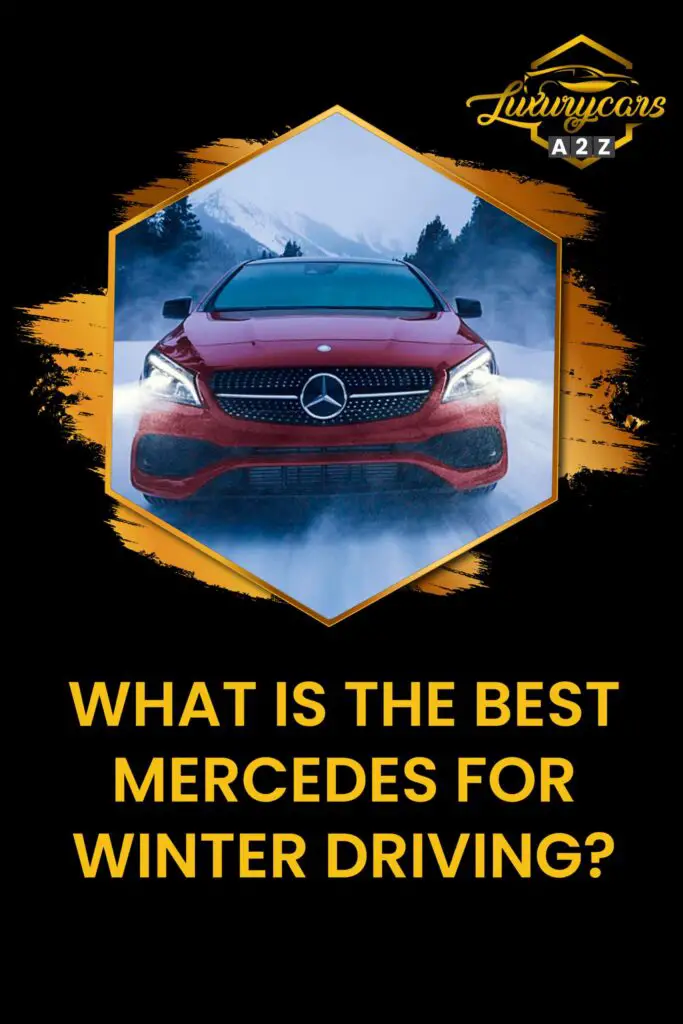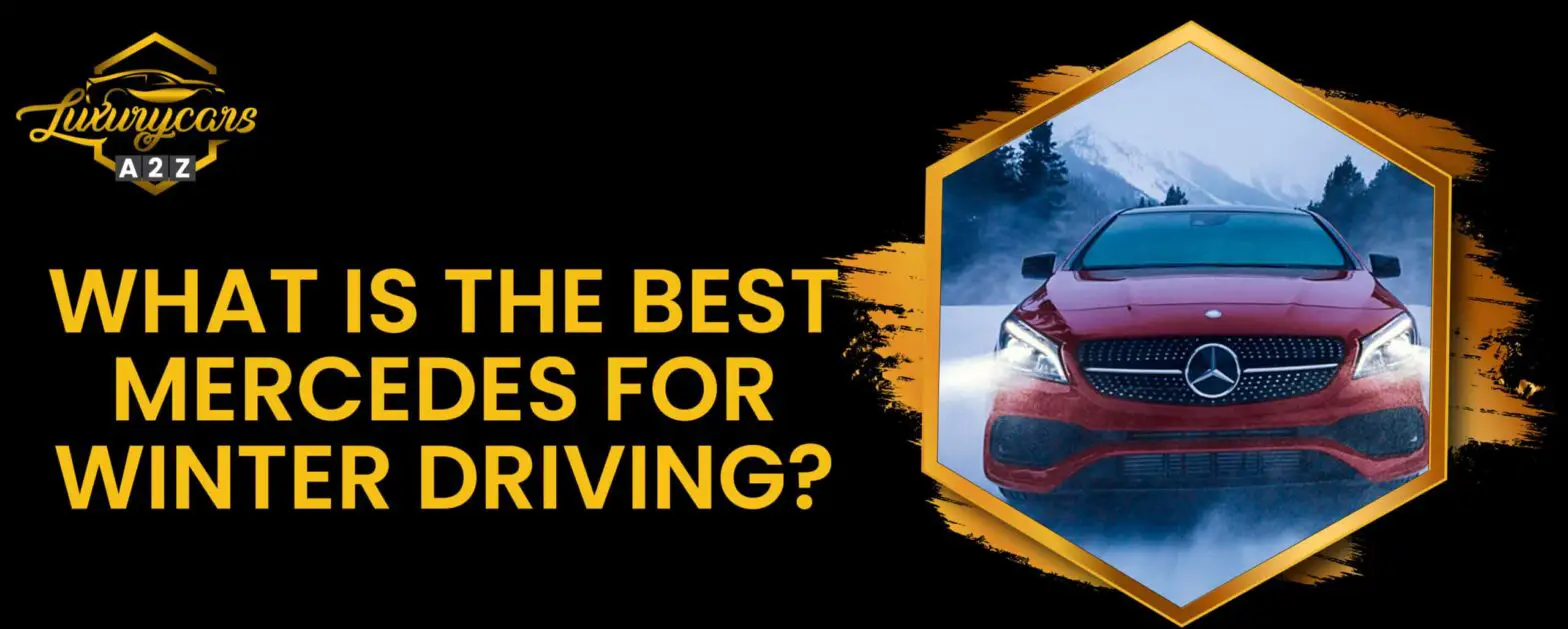As soon as winter arrives, driving conditions change dramatically. Gone are the days of sunlight and AC in favor of grim weather and heated seats. Mercedes makes a large variety of different models encompassing even the most unpopulated market demands, many of which excel in grim conditions.
Some countries experience winters considerably worse than others, but what are the best Mercedes models, even for the worse of conditions?
Characteristics of a good winter car
There are some features modern-day cars offer that are a must, no matter where you live, or how severe the winter in your country might be. In addition to nice add-ons like heated seats, steering wheels or armrests, some features should not be overlooked.
Climate control
The first important feature is a well-functioning climate control system. Keeping the occupants in a cozy temperature is a must, plus a properly functioning AC climate system dries out the excess moisture out of the defroster/heater system which keeps your windshield from fogging up and impacting safety as a result.
Winter tires
Probably the most important aspect of winter driving is winter tires. Winter tires are constructed with wider gaps compared to regular ”summer” tires. They increase traction in subpar weather conditions mostly associated with winter. Moreover, winter tires are made to withstand lower temperatures without impacting traction, and some of them even use metal spikes for ice driving.
4-wheel drive
Four-wheel drive systems are also beneficial in winter conditions, as they distribute power depending on the traction of each wheel. They work in a manner that ensures optimal traction performance, no matter the weather conditions. That being said, they don’t do wonders and when driving in winter conditions, you should always tread carefully.
Ground clearance
In addition to these features, you should also be aware that in snowy conditions, even the best four-wheel-drive systems will fail if your car suffers from low clearance. Ground clearance is the distance between the ground and the undercarriage of a car. That’s primarily the reason why sports cars are almost always reserved for conditions not involving snow.
Best Mercedes SUVs for winter driving
It comes as no surprise that the best winter cars Mercedes currently offers for driving in snowy and icy conditions are SUVs. SUVs beat sedans, hatchbacks and estates in almost every characteristic mentioned above.
Pretty much every SUV comes with a four-wheel-drive system because it’s half of the appeal of an SUV. The ability to go anywhere anytime serves as a prominent reason why people love SUVs so much. And if that is the main reason why you consider SUVs, you should look into the almighty G-class.
The G-class was made for military purposes in the 70s and since has become somewhat of a posh chariot for people who can afford it. While most G-classes spend their days in between school and shopping runs, no one can deny the G-class being one of the most capable serial production off-road cars ever built.
The G-class has had a first major overhaul recently, making it a compliant road car but still keeping all of the off-road goodies. The G-class offers three different locking differentials, and that’s rare in a factory car. A car differential allows the outer wheel to spin faster than the inner wheel, and vice versa, which increases traction significantly.
While it’s hard to dispute the G class being the most capable Mercedes nowadays, one should not forget all the other Mercedes SUVs, especially the GLE and the GLS. The GLS is equipped with the Off-road package that offers many goodies to ensure optimal winter driving conditions. The same goes for the GLE because size is mostly the only difference.
Best Mercedes sedans and hatchbacks for winter driving
If the winter conditions where you live aren’t that extreme, you can get by with a sedan, rather than an SUV. So, if SUVs are not your thing, you can always opt for different Mercedes offerings.
You might get the best of both worlds if you tick all the right options. As mentioned, most SUVs come with four-wheel drive as standard, but Mercedes also makes four-wheel-drive sedans and even hatchbacks.
If you want a four-wheel-drive system, it’s likely you’ll have to opt for a six-cylinder engine at a minimum, or even go the AMG route for a four-wheel-drive hatchback.
Also, keep in mind that big sedans with only rear-wheel drive and without decent winter tires, are fairly dangerous to drive in winter conditions.
- Want to know more about buying a used Mercedes and if a high mileage Mercedes is a good idea.
FAQs about winter driving
How important are winter tires in winter conditions?
Winter tires are extremely important. It’s a no-brainer. If you can afford a car in the first place, you are probably able to afford winter tires. If not, then you might not have your car for long. Granted, it depends on how severe winters are in your area, or if you are using all-season tires or summer tires.
A survey made by Nokian tires shows that in France, 44% of French people use the wrong types of tires during a specific season. It’s also no wonder that the Germans are most aware when it comes to winter tires.
Buying winter tires is even a legal requirement in many countries. While you might be able to put a price on winter tires, you can hardly do the same for human lives. So, next time the temperature drops to sweater levels, consider investing in winter tires.
What’s the difference between four-wheel drive and all-wheel drive, and which is better in the snow?
The principal difference between these two systems is that all-wheel-drive systems, commonly referred to as AWD, constantly power all four wheels at any given moment, which is beneficial for icy and moderately snowy roads.
On the other hand, four-wheel-drive systems, commonly referred to as FWD, are a bit more complex. Cars with four-wheel-drive usually have a bias front or rear, and they send adequate torque front or rear depending on the conditions and grip levels. Therefore, FWD systems might prove more useful in deeper snow or other extreme winter conditions.
What are the best winter Mercedes cars of all time?
While this question might seem rather abundant, it makes quite a bit more sense when you count in all the one-off projects by Mercedes, which are the result of Mercedes engineers having a bit more freedom in flexing their engineering muscles.
Not all G-classes are made equal. In 2013, Mercedes started the production of the mighty Mercedes AMG 6×6 offering 6×6 portal axels. The vehicle weighs in at a colossal 4 tons and can travel 100mph due to the 536 horsepower V8 AMG engine. The vehicle costs north of half a million dollars or more.
Similar models are the ”more” attainable G500 4×4² priced around 200-250k euros, also being an off-road tank.
But the title for the craziest off-road Mercedes model probably goes to the Mercedes E-class All-terrain 4×4². As it happens Mercedes had a couple of spare G500 4×4² laying around and they decided it would be a good idea to strap it onto a family wagon.
While all of these might seem a bit childish and utterly useless, it’s important to remember that some of the best cars ever made came from projects engineers were doing on the off-hours.
Are Mercedes good in the snow?
There are various Mercedes-Benz models that are pretty good choices if you live in an area with a lot of snow, and there need a good car in the snow. If you want the absolute best Mercedes for snow, you should check out the Mercedes E-class All-terrain 4×4².
Read more about the best Mercedes for snow.
Is Mercedes 4matic good in snow?
Mercedes 4matic is for sure good in snow, and the reason multiple of their cars are good choices if you live in an area that gets really icy and with a lot of snow in the wintertime.
Is Mercedes GLA good in snow?
The GLA is great in snow. The 4MATIC(r), all-wheel drive, is available in almost every Mercedes-Benz model. It can handle any weather conditions. 4MATIC(r), which is available in almost all Mercedes GLA models, makes it possible to drive on snowy terrain, in wet conditions, or on dry terrain.
Is Mercedes GLC good in snow?
Because of its 4-Matic AWD and generous ground clearance, the Mercedes GLC excels in snow conditions. You can use Stability Control, Traction Control and Brake Assist technology. You can drive comfortably and safely in winter thanks to the combination of these features in the GLC.
Is the Mercedes C300 good in snow?
The Mercedes Benz C300 is a fantastic choice for driving in snow, especially when equipped with 4Matic AWD. The Mercedes Benz C300 has proven its worth in harsh winter conditions. It features a wide range of features, including ABS, Traction Control, Remote Engine Start, and heated seats. These features provide safety and comfort even in severe weather.
How do you drive a Mercedes in the snow?
1. You must ensure that your vehicle is in top condition
2. Take care when planning your route
3. Make sure you have enough fuel
4. Keep an ice scraper and de-icer handy
5. Be alert
When Should snow tires be put on?
Outdoor temperature is the best way to determine when winter tires should be installed. It’s time for winter tires to be installed once the average daily temperature drops below 45° Fahrenheit (7° Celsius).
Are RWD Mercedes good in snow?
RWD works well in light to moderate amounts of snow, provided you have excellent tires and can drive. The location of your drive wheels doesn’t really matter once you’re on glare.
What about other car brands? Is Volvo good in snow? Is Audi good in snow?


